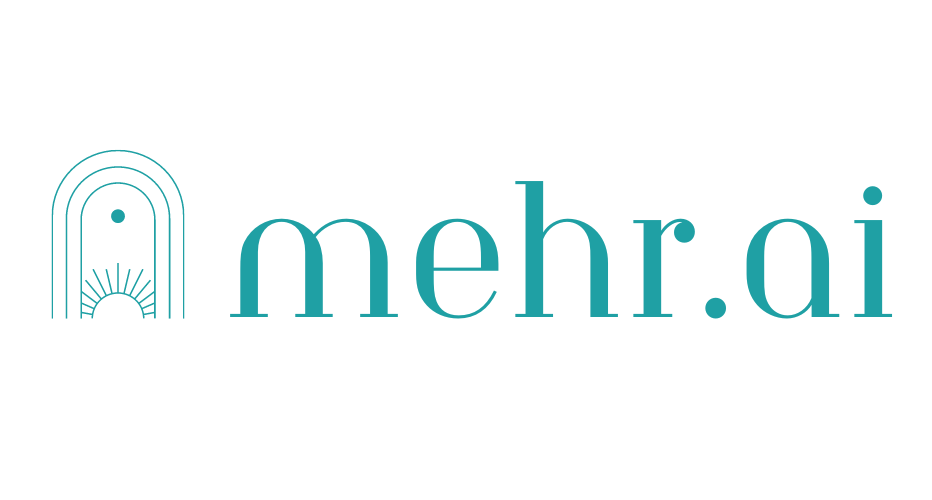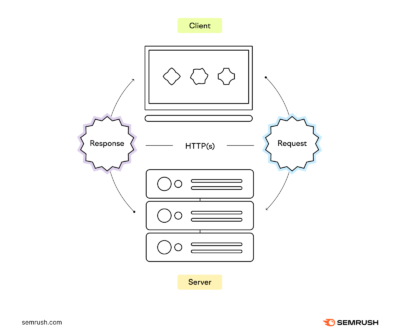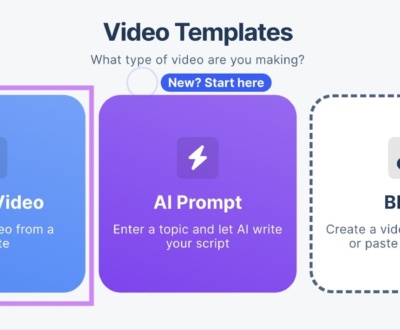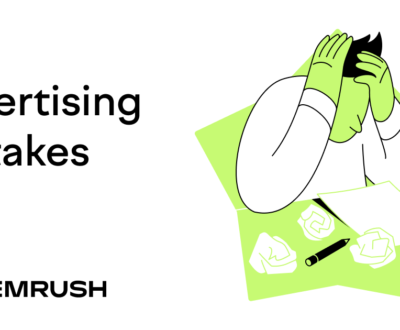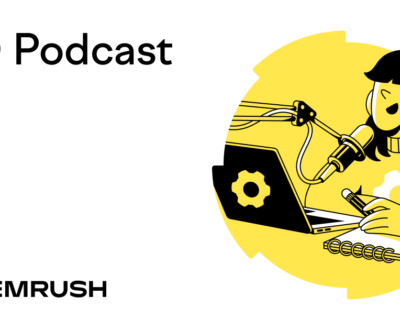[ad_1]
On August 22, 2023, Google introduced the discharge of its August 2023 core replace.
Right this moment we launched the August 2023 core replace. We’ll replace our rating launch historical past web page when the rollout is full: https://t.co/sQ5COfdNcb
— Google Search Central (@googlesearchc) August 22, 2023
This core replace was not solely the primary one launched since March 2023 but in addition one of many extra peculiar updates I’ve seen. The rank volatility tendencies surrounding the replace have been unprecedented, which makes diving into this replace notably fascinating.
The Distinctive Rank Volatility Patterns of the August 2023 Core Replace
How impactful was the August 2023 core replace? For a little bit of context, let’s take a look on the wider volatility patterns surrounding the replace.
Right here’s what rank volatility regarded like each instantly earlier than and through the August 2023 core replace:
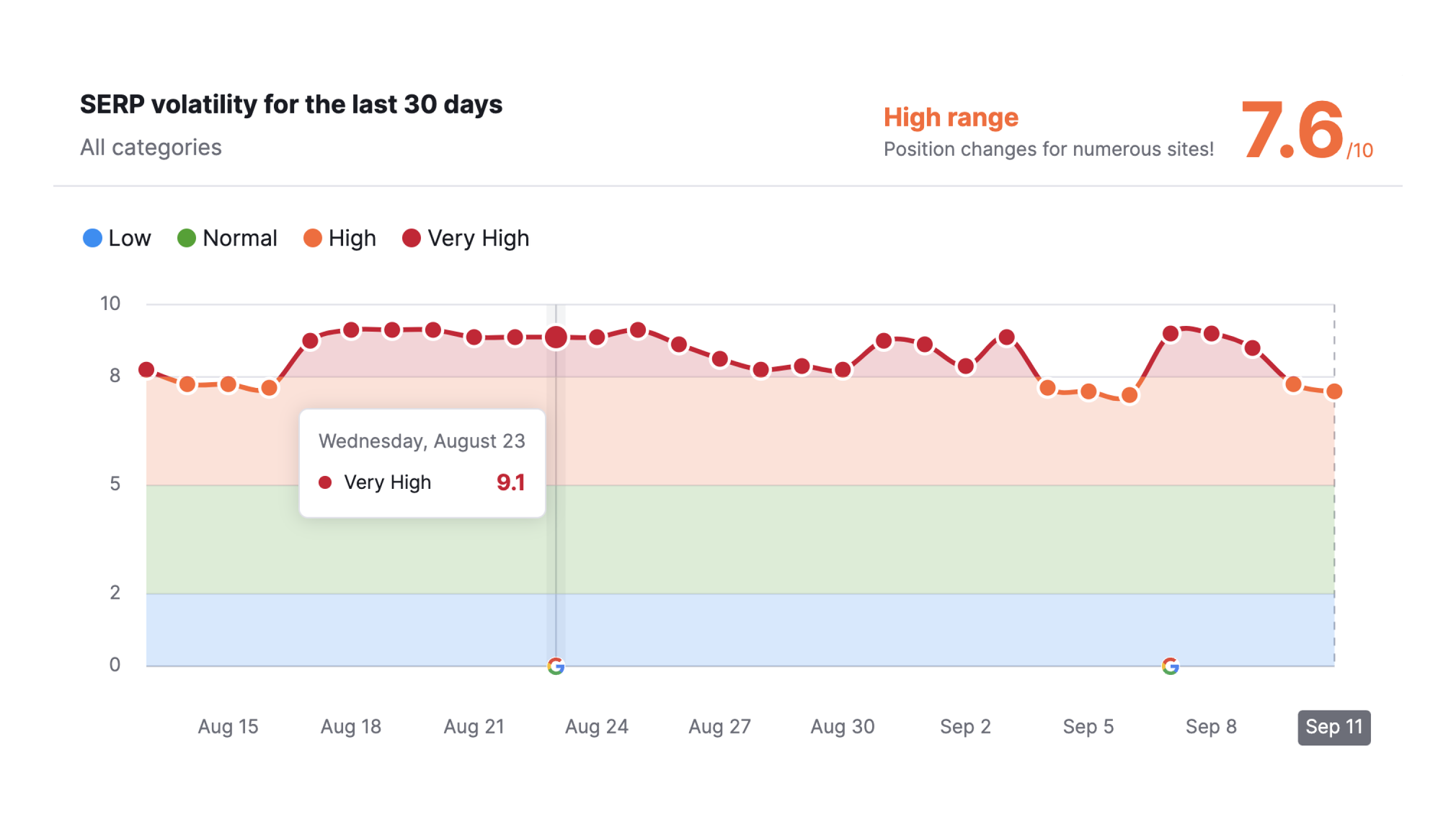
Do you discover something lacking?
The normal surge and spike in rank volatility is absent. Usually you’ll see a transparent and demarcated spike in rank volatility on the Semrush Sensor a day or two right into a core replace.
There isn’t any spike right here. The closest factor to it’s a late (and pretty widespread) surge in rank volatility towards the tip of the replace’s roll-out, circa September 5.
That is very peculiar by way of how core updates “behave.”
Actually, if we go a bit farther again in time to mid-July 2023, you’ll see persistently excessive ranges of volatility for over a month.
That sample, mixed with the absence of the standard “core replace volatility spike,” makes the August 2023 core replace fairly uncommon.
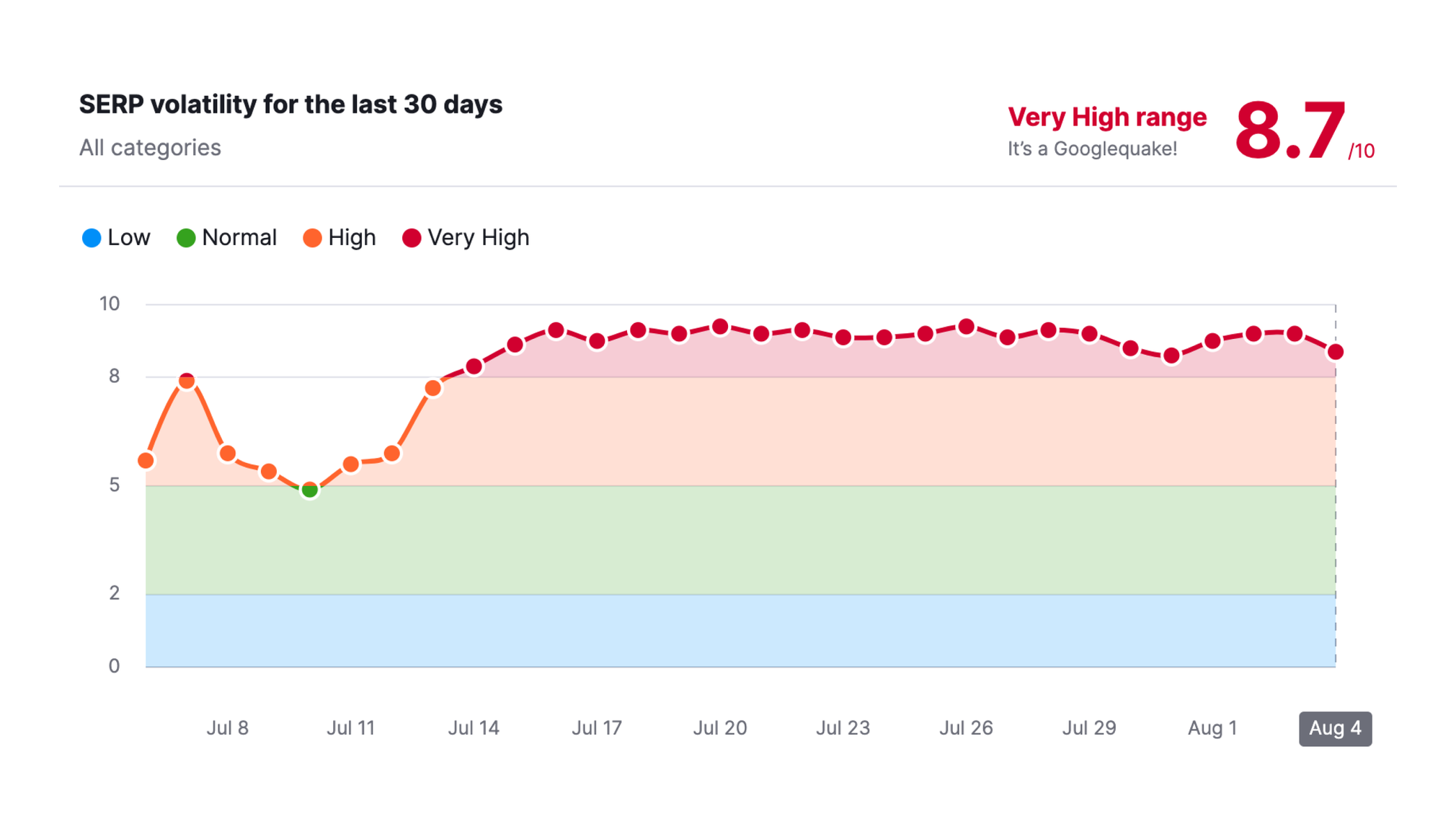
If we pull out the typical ranges of rank volatility over the previous few months, the pattern I’m making an attempt to level out turns into vividly clear: an virtually unprecedented degree of rank volatility not solely through the August 2023 core replace however instantly surrounding it (which begs the query of how interconnected all of this rank volatility truly is).
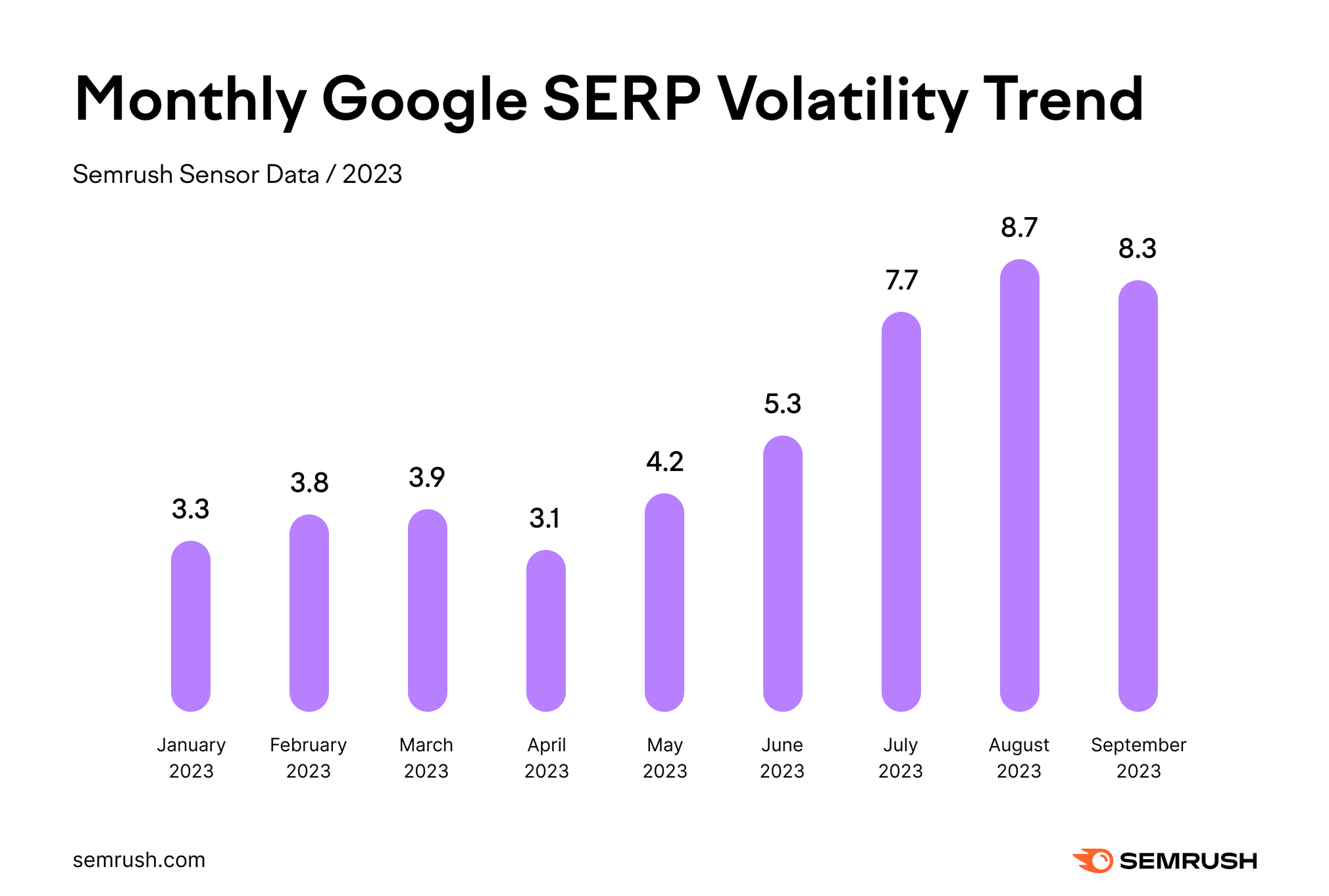
Actually, after we break down the rank volatility ranges only a bit and have a look at some weekly averages because the begin of the 12 months, the dearth of an “replace spike” turns into way more pronounced.

The July 2023 knowledge above depicts the spike in rank volatility we’d count on to happen with a core replace.
(This isn’t to say I’m concluding the spike was instantly associated to the core replace, however to imagine they’re utterly unrelated doesn’t make sense, both.)
So what you mainly see is a big surge in rank volatility in July that tapers off only a bit in early August earlier than spiking once more a number of days earlier than the replace’s roll-out, with a remaining receding of the viability components because the replace concluded.
It’s no coincidence that we see a pattern towards typical ranges of rank volatility solely with the replace’s completion. If all of those volatility spikes are unrelated to one another, then with the replace’s completion, why didn’t volatility stay excessive?
It additionally makes pinning down its mixture and relative impression a bit trickier than normal.
How Risky Was the August 2023 Core Replace?
Now that we higher perceive the complexity of that query, let’s dive into a few of the knowledge the Semrush analytics staff pulled out of the replace.
However earlier than we get into the info, it’s price repeating that figuring out the relative impression of a Google replace may be very difficult and nuanced, regardless of how the subject is commonly offered.
There are all types of the way to slice and cube the impression of an replace; as a rule, you can’t use one metric to find out the impression of an replace in comparison with one other replace.
And even with a number of metrics, as you’ll be able to see above, general ranges of volatility surrounding the replace will impression the metrics and cloud the info image. Asking about an replace’s impression is a much more complicated query than it’s typically offered.
With that, right here’s our nuanced tackle the impression of the replace.
Peak Rank Volatility Throughout Google’s August 2023 Core Replace
Let’s begin with in all probability the best metric to intuitively perceive, the height ranges of rank volatility seen through the August 2023 core replace relative to the March 2023 core replace:
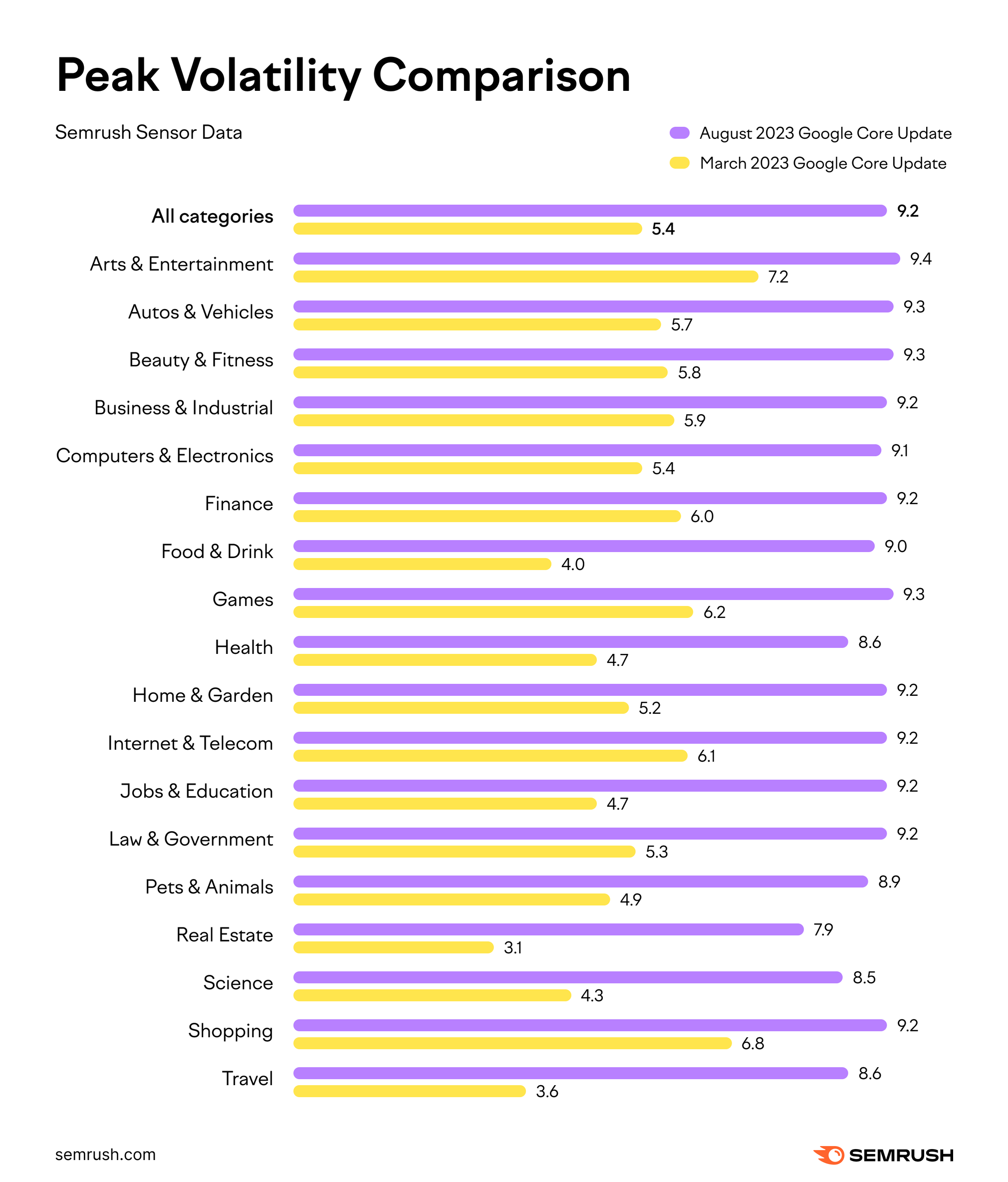
Clearly, the August replace exhibits far higher ranges of peak volatility than its March predecessor. Again in March, we didn’t have a single vertical present a peak volatility degree higher than 7.2.
Examine that to the latest replace, and we now have all however 3 verticals exhibiting volatility ranges of 9 or above. Even in these 3 verticals, the bottom peak volatility seen was 7.9, whereas the very best in March was 7.2.
That exhibits the August 2023 core replace was way more highly effective than the March 2023 core replace, proper?
Unsuitable.
That is why context is vital—you can’t depend on a single metric to guage the energy of an replace.
Take a look on the volatility tendencies of the 2 updates facet by facet. What do you discover (except for the dearth of a conventional spike in August and the presence of 1 in March)?
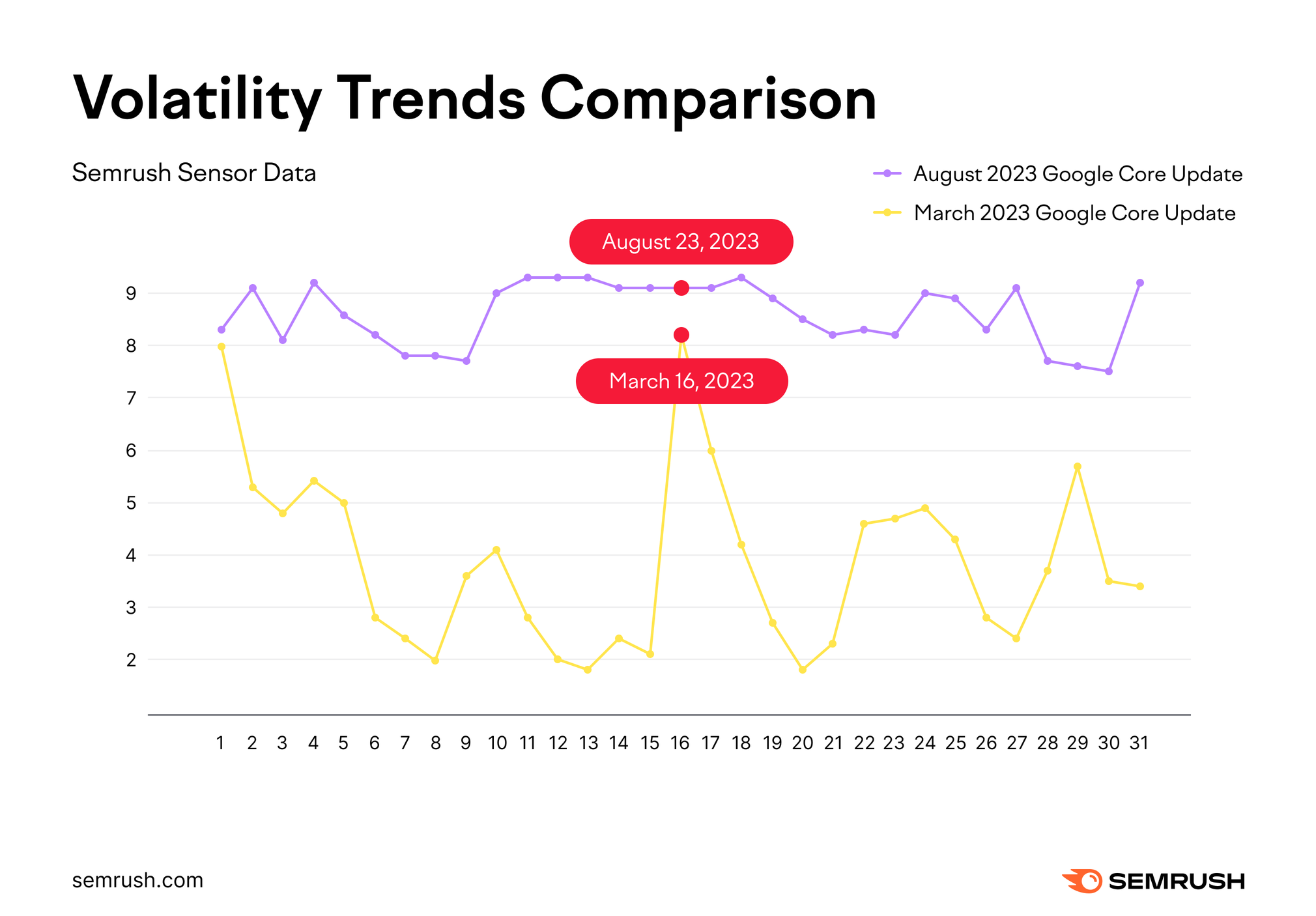
The degrees of rank volatility throughout August have been already excessive. Figuring out the energy of the updates based on peak volatility on this case merely isn’t a good comparability.
Let’s say that the standard replace will increase the baseline pre-update rank volatility by, for instance, 3 factors.
If the baseline rank volatility for an replace is at 3, it’ll go as much as 6. If the baseline is at 6, then the height volatility might be round 9. Does that make one replace extra impactful than the opposite? Clearly not.
That’s precisely what occurred on this case.
So whilst you’re seeing extra volatility general, it is probably not as a result of replace per se however the general “volatility setting.”
This implies we have to have a look at the volatility enhance and alter relative to the baseline pre-update knowledge.
Rank Volatility Will increase Throughout the August 2023 Core Replace
The following layer in our quest to know the rank volatility image painted by the August 2023 core replace is to match the rise in volatility seen relative to the degrees of rank fluctuations previous to the replace (which, as a result of irregular ranges of pre-update fluctuations, we needed to go all the best way again to a “calm” interval in July).
Right here’s how modifications in rank volatility evaluate between the August and March core updates:
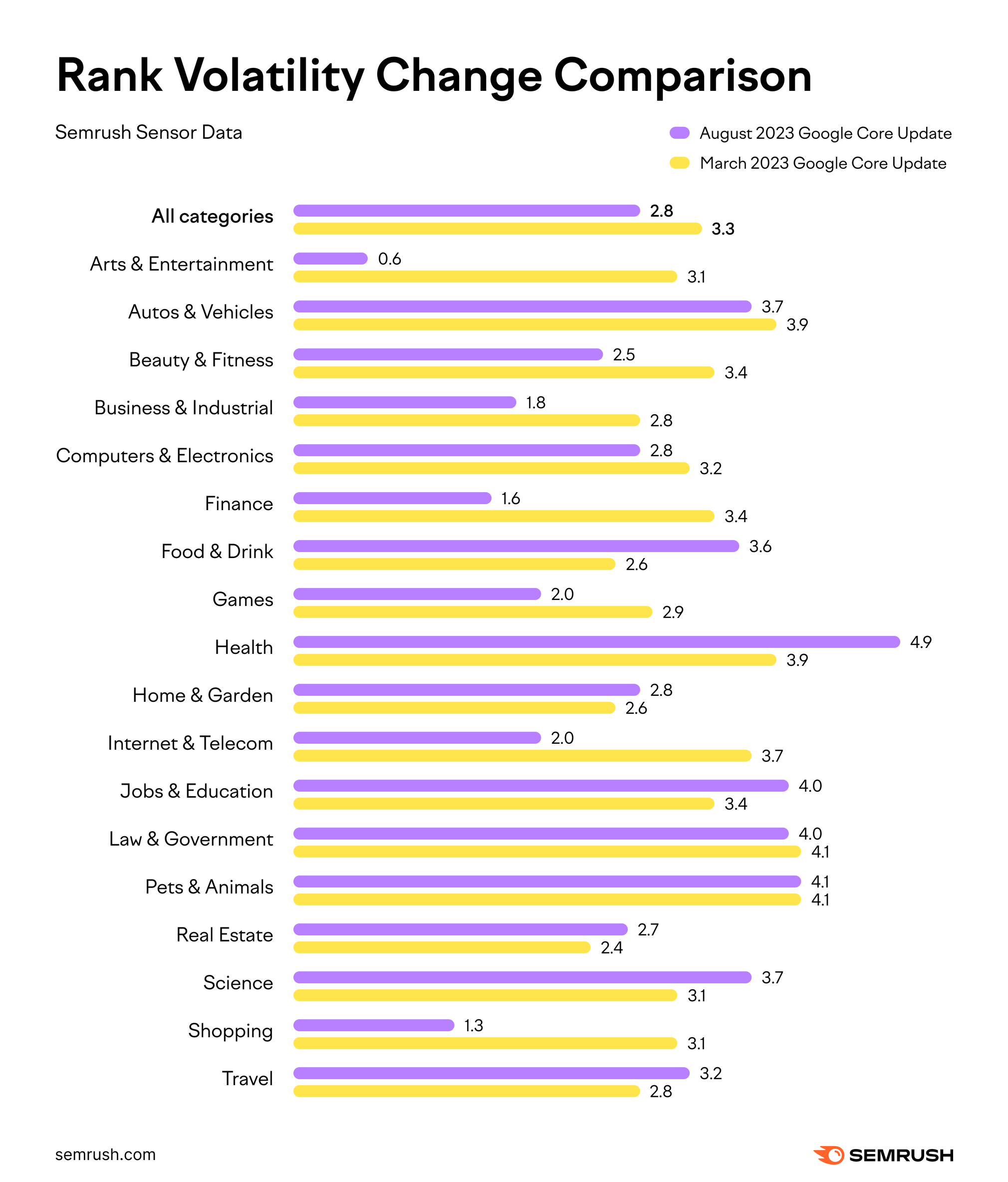
Evaluating the baseline knowledge to the degrees of rank fluctuations seen through the replace itself, it will seem that the March 2023 core replace was extra highly effective: March noticed a rise of three.3 factors on the Semrush Sensor whereas the August replace exhibits a rise of solely 2.8 factors.
And there you could have it…besides there’s one thing fascinating about this knowledge.
Usually, if one replace is “extra impactful” than one other, it’s fairly common throughout all verticals (with perhaps one and even two outliers).
Not so right here.
As you’ll be able to see above, there are 6 verticals exhibiting a higher enhance in volatility through the August 2023 replace than through the March replace.
And after we in contrast the March 2023 core replace to the September 2022 core replace, there have been zero verticals from September exhibiting a higher enhance in volatility.
However even when the pre-update baseline have been “typical,” we nonetheless wouldn’t have sufficient knowledge to find out which replace was extra highly effective.
Why not?
As a result of extra general volatility doesn’t essentially imply that the volatility is extra extreme.
As an example, perhaps there’s a ton of elevated rank volatility but it surely’s all URLs shifting up and down within the SERPs a place or two; would that actually be one thing we’d name a really “impactful replace”?
Wouldn’t we now have to have a look at how extreme the rating shifts have been?
How Extreme Have been the Rating Shifts Throughout Google’s August 2023 Core Replace?
Ask and ye shall obtain.
Let’s take a look on the common place modifications throughout each the August 2023 and March 2023 core updates.
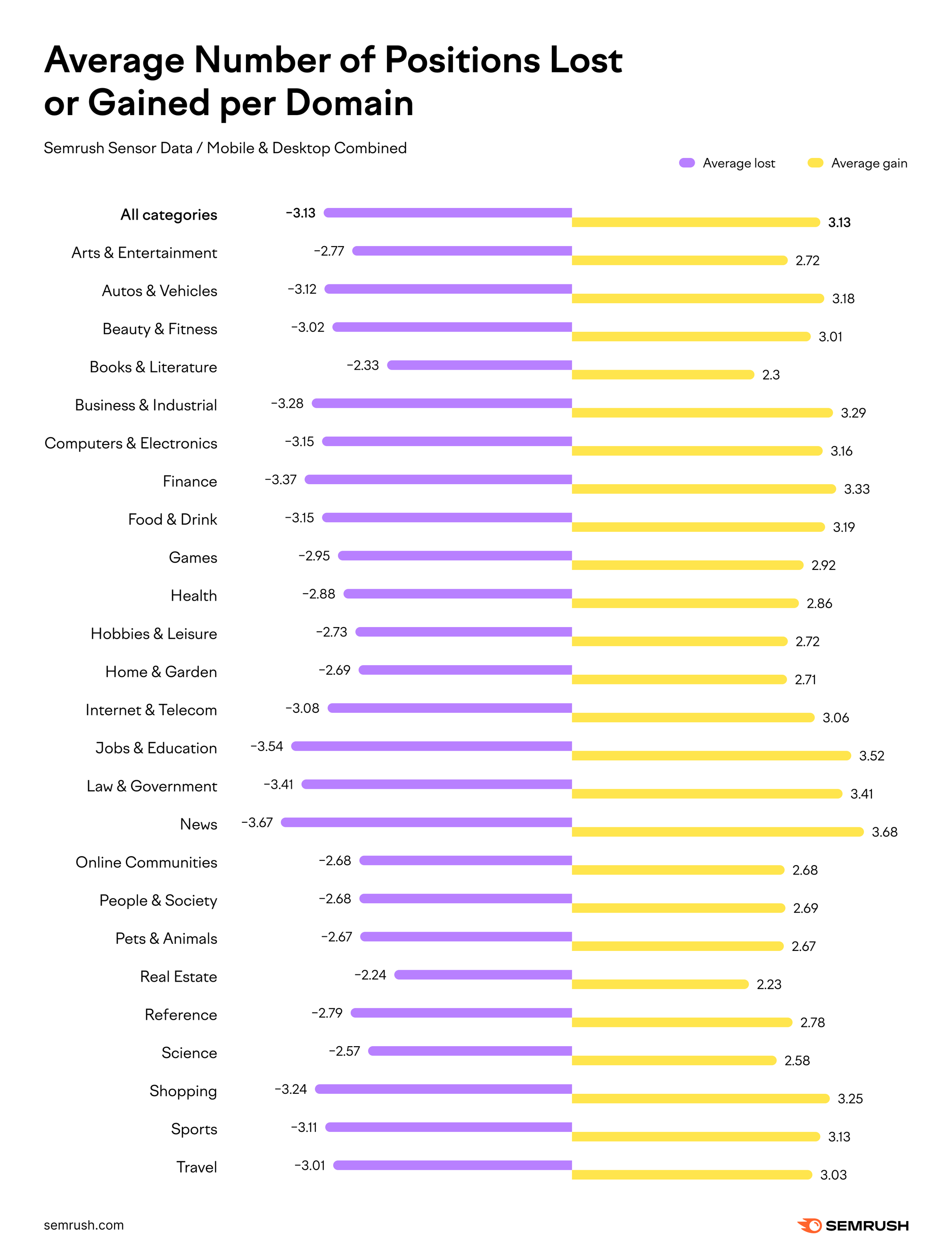
Primarily, the typical “fluctuation” moved a URL roughly 3 positions up or down the SERPs.
Comparatively, again in March the typical “fluctuation” stood at 2.7 positions.
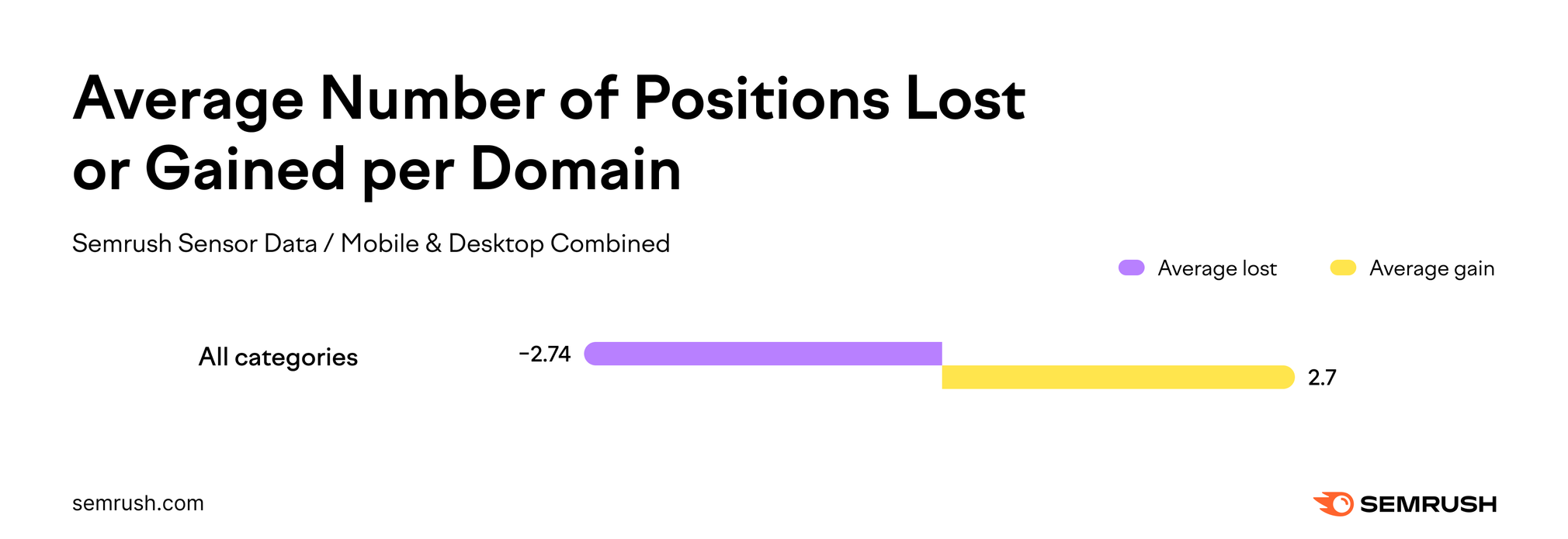
So from this angle, regardless of the general enhance and modifications in rank fluctuations being higher again in March, the August 2023 core replace was extra impactful.
That is supported by the proportion of URLs now rating among the many prime 10 outcomes that have been beforehand rating past place 20.
Because the beneath graph exhibits, practically 11% of URLs rating prime 10 following the August 2023 core replace ranked past place 20 previous to its roll-out.
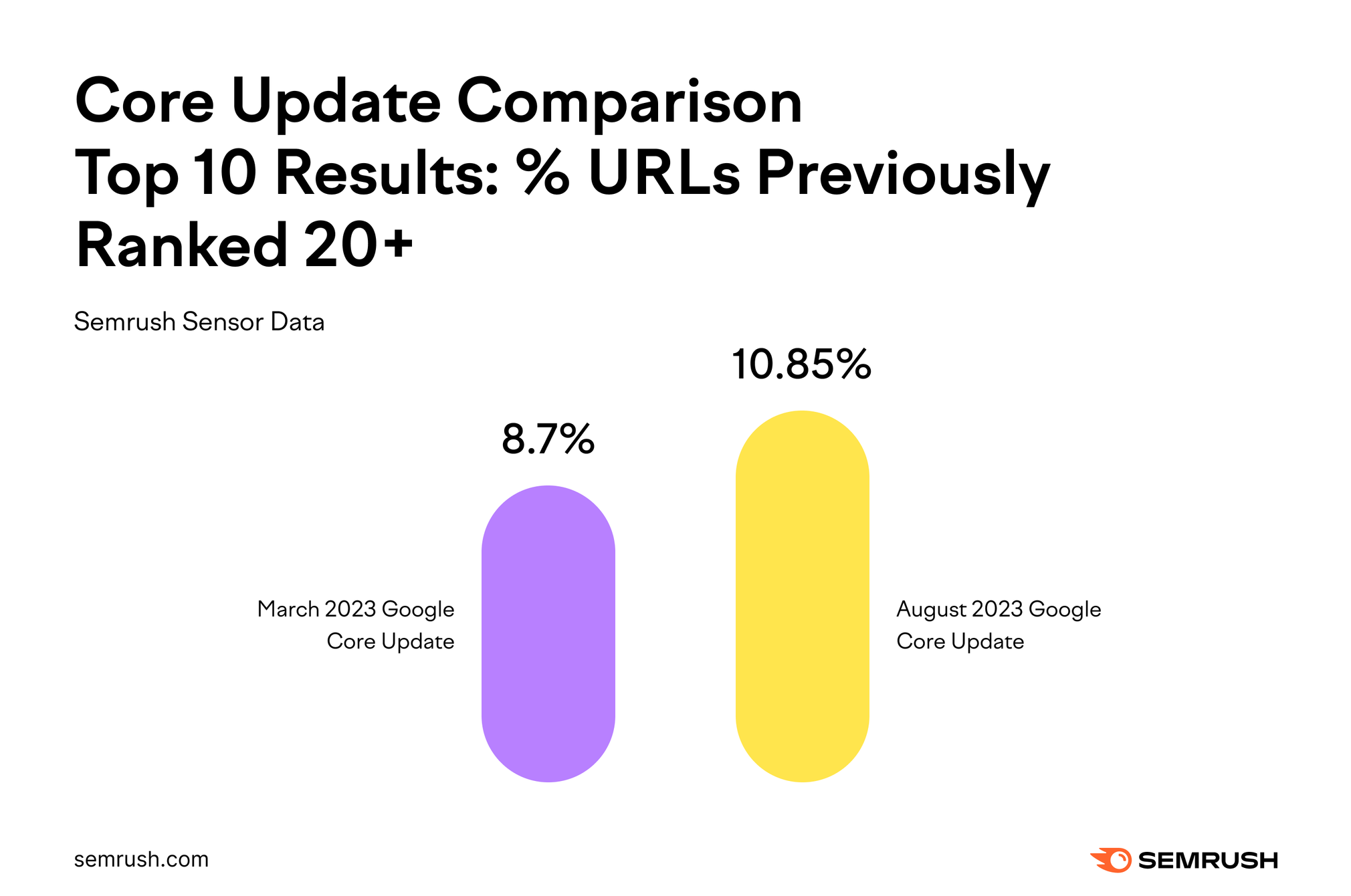
This stands in distinction to the March replace, the place simply over 8.5% of URLs within the prime 10 ranked past place 20 previous to that replace.
Persevering with the identical sample, 22% of the URLs rating prime 20 post-update are new. Previous to the replace, they ranked past place 20.
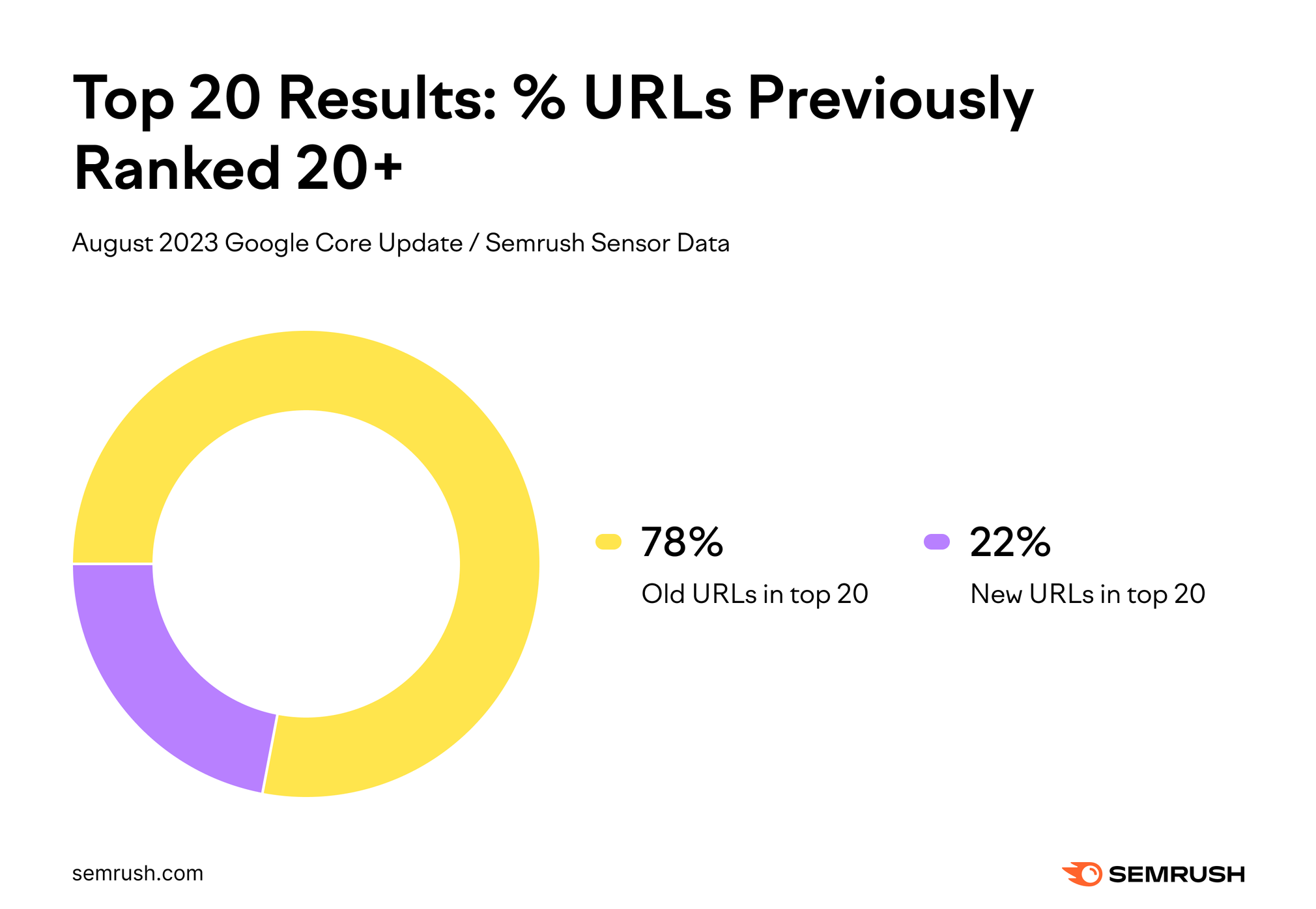
Right here too, after we evaluate the identical knowledge to the March 2023 core replace, the identical sample relating to the highest 10 outcomes emerges: a higher proportion of the URLs rating prime 20 after the August 2023 core replace.
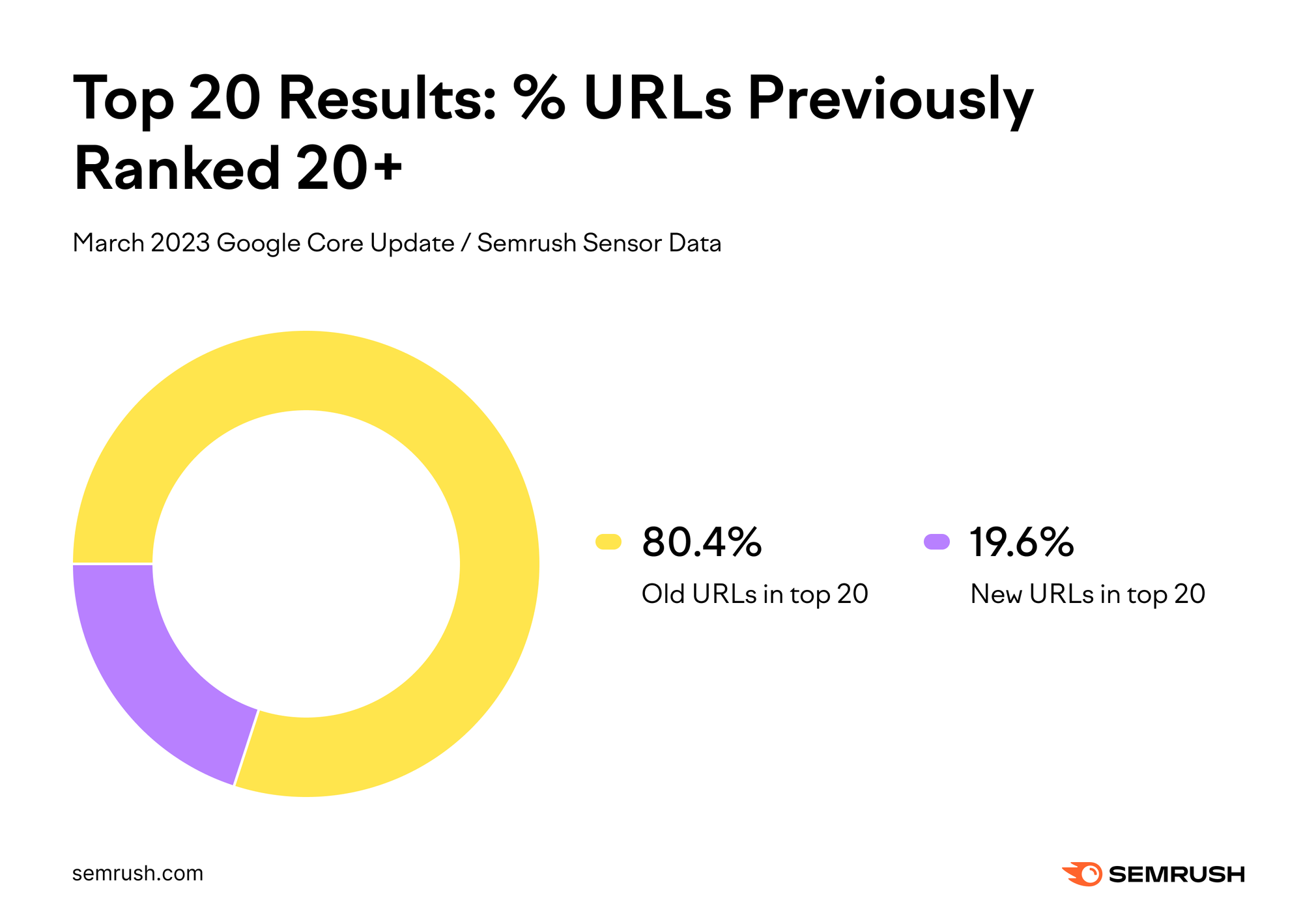
As the info clearly exhibits, 19.6% of the URLs rating prime 20 after the March replace got here from the netherworld of the SERPs (i.e., past place 20). That quantity was 22% post-August 2023.
Thus, from this particular perspective (i.e., how dramatic have been the rating shifts), the August 2023 core replace appears to have been “extra impactful.”
Are You Confused?
You ought to be (form of). There’s no linear equation for figuring out how impactful a Google replace is. A number of knowledge factors (greater than we’ve included right here) and the numerous methods to interpret outcomes can cloud the image.
On prime of that, even with Semrush’s enormously giant knowledge set, nobody—in all probability not even Google—can totally perceive the impression and modifications an replace leaves in its wake.
I hope you now have a greater understanding of the impression the August 2023 core replace left on the SERPs and the websites that seem there.
However greater than something, I hope you realized that making a dedication about an replace’s impression is complicated, nuanced, and a bit left as much as interpretation.
[ad_2]
Supply hyperlink
About us and this blog
We are a digital marketing company with a focus on helping our customers achieve great results across several key areas.
Request a free quote
We offer professional SEO services that help websites increase their organic search score drastically in order to compete for the highest rankings even when it comes to highly competitive keywords.
Subscribe to our newsletter!
More from our blog
See all postsRecent Posts
- What Is It & Tips on how to Do It December 7, 2023
- What It Is and The way to Use It December 7, 2023
- High 10 Content material Repurposing Instruments for 2024 December 7, 2023
